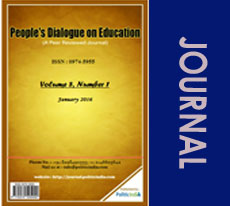ILLCONCEIVED EFFORTS IN REFORMING SCHOOL AND TEACHER EDUCATION IN BIHAR
- Post By PoliticIndia.com on
- 2013-10-02 23:15:30
ILL-CONCEIVED EFFORTS IN REFORMING SCHOOL AND TEACHER EDUCATION IN BIHAR
The Report of the National Education Commission (1964-66) states: The destiny of India is now being shaped in her classrooms. This, we believe is no more rhetoric. But during last fifty years the statement proved to be rhetoric. Instead of getting empowered, Indian classrooms are losing their capacity to shape the destiny of India. The situation is so alarming that no one except those unable to afford education of their children sends them in government schools. It appears that the state feels constrained shouldering the responsibility of quality school education of the common children. Efforts are being taken to ensure right to education (RTE) to the children across the country but the approach being followed reflects that the state is searching for a mechanism where children will be enrolled in schools and will complete their elementary education without attending schools, without learning, and without evaluation. Many state governments have recruited a large number of para teachers or contract teachers on a meager salary. In a state like Bihar over two lakh teachers were appointed on a consolidated salary of 6000 to 10000 at primary, middle (elementary), secondary and senior secondary stages. It is already in process of appointing other one lakh similar teachers. The Bihar Government abolished the permanent cadre of school teachers who used to get full salary as per given scale. Any such permanent teacher once retires; his/her post will be abolished. The quality of teachers is bound to be poor as no person even with average talent and commitment will aspire to be a school teacher. Full time contract teachers working in primary to senior secondary schools get salary less than a peon. The current system of promoting all children to their next grade till class 8 is based on the principle that all without exception shall achieve the minimum criteria fixed for learning at a particular level. Full time and regular attendance of children is still a distant dream. The fulltime attendance of children in elementary school is not more than forty percent .The quality of teaching is poor. A substantial proportion of teachers working in primary and middle schools are untrained or not received two years initial training (D.Ed./ D.El.Ed) needed for primary/elementary school teachers. Many a trained teachers have one year B.Ed. degree suited for secondary/senior secondary school teaching. The state has 2.7 crore students in Classes I to XII in its 74,000 government schools, that engage over 5.5 lakh teachers. According to Bihar Economic Survey 2013, number of primary and middle government schools in the state is 68,323 and number of teachers in these schools is 3.8 during 2011-12. No data is available about secondary and senior secondary schools in the survey report. Teacher-student ratio in secondary and senior secondary schools of Bihar is most adverse in the country The official data shows private education as an entirely insignificant part of the educational landscape in Bihar. The District Information System for Education (DISE) data for 2008-2009 estimates a total of 93 private schools for the whole of Bihar. Provisional data for 2009-10 suggest 14 private schools in the entire state. However, the 64th round of national sample survey (Education in India: Participation and Expenditure) by the National Sample Survey Office (NSSO) in 2007-08 pegged the extent of unrecognized schooling at a much closer level to reality. Interviewing households, as opposed to enumerating schools has given a realistic picture in this regard. The NSSO calculates that 43.8% of the primary school children in urban Bihar go to unrecognized private schools. Unrecognized schools cater to 25.5% of the students in the state. Article 18 of the RTE Act, 2009 requires that all unrecognized schools to be closed down within three years of the Act coming into force and open sufficient number of quality government schools for our children. There is little hope that conditions of government schools will revive, instead there is every possibility that conditions will deteriorate in these schools. For ensuring quality education in government schools, Bihar has introduced report cards in government schools for students, teachers and schools from the 2013 academic year. Landmarks have been identified for learning to judge students while teachers would be rated on everything from punctuality to their reading habits. A school will be graded A, B, C and D on a scale of 150 marks and will be judged on some 70 parameters, from its infrastructure and management to its community participation and academic achievements. The report cards will be monitored by over 6,000 cluster resource centre coordinators visiting these schools. State Government has been working with the Azim Premji University, Bangalore based private university, to train teachers and select education officers. School Report Card will provide report on school performance. In these report cards, schools will have to detail every service they provide and what they don't. They will also have to put in their student-teacher and teacher-classrooms ratios, as well as how many times parent-teacher associations, school committees, eco and science clubs met in a year and how many times school inspectors visited them. A school will also have to put in the number of classrooms in use, if there are separate toilets for boys and girls, and if these toilets are functional (www.indianexpress.com , Feb 12, 2013). The above system will hardly have an impact on the quality of education. Without ensuring quality teachers and quality life conditions to them, quality education cannot be ensured. It is a hard fact that the key player in the school process is the teacher. Mahatma Gandhi said: I have always felt that the true text book for the pupil is the teacher. A true teacher is a role model who triggers the thought process of his students to realize their true potential. He teaches by practice and not merely by precept (Justice Verma Commiittee Report Vol 1. preface). The Kothari Commission says that no person can rise above the status of its (society) teacher. At the same time one must recognize the fact that quality school education is the essential factor for development of any society. Quality of higher education will obviously depend upon quality of school education. For quality school education, there cannot be any shortcut. Quality education is only possible if school is very attractive to our children; such socioeconomic conditions are created where children are willing to visit their schools and stay fulltime and meritorious students from colleges and universities are eager to enter into school teaching; capacity building of teacher training institutions must be strengthened to their fullest; schools themselves be made accountable for quality teaching-learning processes and should be freed from any kind of bureaucratic control; and teachers are never engaged in nonacademic governmental duties. All these require a strong political will and huge expenditure. Arguments and findings are often placed by state bureaucracy and vested interests that teachers getting full salary do not perform or low paid teachers perform better than teachers getting full salary. It is very difficult to subscribe to such ideas, arguments and studies because It is well known that highly paid Indian bureaucrats never performed well. Quality elementary education is the fundamental right of our children and to ensure this right the state should cut down salary and expenditure in other sectors in case the state faces resource crunch and does not have sufficient money to spend on the education of children. The system of report cards introduced in primary schools of Bihar will be of no help in improving these schools. Schools are already facing three fold monitoring system. Panchayati Raj Institutions and Municipal Corporations are statutory bodies and monitoring of elementary education fall within their jurisdiction. Vidyalaya Siksha Samiti (VSS) Act was enacted to monitor school functioning primarily by the parents. Apart from these two, education officers make direct monitoring of primary schools. The school head lost not only his or her vision but lost rapport with their own teachers under three fold monitoring system. Block Resource Centres (BRCs) and Cluster Resource Centres (CRCs) were established in 1990s to empower teachers through block level short term in-service training at BRCs and monthly recurrent training at CRCs. These training programmes were visualized as self-empowerment programmes of teachers. Resource persons and coordinators were identified from among them. All the BRCs were equipped with a small resource centre and facilities for residential training of teachers. Gradually a large number of the BRCs were encroached by administrative and other block level officers. Almost all BRCs are in shabby conditions and not fit for residential training. Most of the resource persons and coordinators identified to help teachers in their self-empowerment programmes gradually developed the habit of not teaching at their schools and behave as they are something different and superior from other fellow teachers. Now around 6000 CRC coordinators have been identified to monitor report cards in primary schools across the state. These people will form another tier for school inspectors. The concept of school grading has been borrowed from NAAC grading of colleges and universities. We have sufficient data to believe that most of our schools are in worst conditions. We are struggling to attain universal functional literacy. Less than half of our population could not read, write and comprehend a language properly. We do not need labeling of schools but we need sufficient number of quality teachers and a school leader getting high salary with best life conditions and autonomy to perform. The school leader or school as a unit should be made responsible for quality teaching-learning of our children. Teachers should keep away from any kind of bureaucratic interference. The school and local self-governments should work together to establish a cordial rapport with parents and community. At the start of the NCTE in 1995 there were less than 800 TEIs in the country. These were mostly in government and aided sectors. Their number rose to around 1900 by the year 2000 and 2500 by 2003. But during 2004-08, a whopping number of 8650 TEIs mushroomed with the concurrence of NCTE, out of which 2439 TEIs were recognized in 2007-08 alone and thus their number by 2008 jumped to more than eleven thousand TEIs. Historically, teacher education was largely in the public sector and teacher education institutions were regularly monitored for maintaining quality. With privatization and liberalization in the field of education, the share of self-financing teacher education institutions in the sector of teacher education has become disproportionately large. Currently, about 85% of teacher education institutions are in the private sector while more than 80% of elementary school children are educated in the State schools. This necessitates the need for an appropriate regulatory framework to ensure quality standards in teacher education. The NCTE, even as a statutory body, has not been able to control the proliferation of sub-standard teacher education institutions due to its inability to enforce the prescribed norms and also inability to continuously supervise the institutions recognized by it. This has led to commercialization of teacher education in the country, thereby adversely affecting the quality of teacher education. (Justice J.S. Verma Committee Report, Vol 1, 2012) A study jointly conducted by UNICEF, Patna and state government (Nov, 2010) found that there are 24 DIETs, 36 PTECs and 6 CTEs in the state, besides 2 B Ed colleges run by Patna University and around 46 private B Ed training institutions. As per information available on NCTE website on 21 April, 2013, there are 53 recognized government primary teacher training institutes of which 14 are DIETS and 39 PTECs. There are 11 private primary teacher education colleges. There are 134 regular secondary teacher education colleges of which 5 are government colleges, 16 are self- financing teacher education departments of constituent colleges/universities, 2 constituent colleges run by Patna University and one by MANUU and 112 are private institutions. In Bihar nearly 84 percent of primary teacher training institutions are in the government sector whereas nearly 84 percent of secondary teacher training institutions are in the private sector. Self -financing B.Ed. programmes of constituent colleges/ universities and private institutions together share 96 percent of secondary teacher training institutions in the state. Joint study by the Government of Bihar and UNICEF, 2010 revealed that None of the DIETs have the sanctioned strength of 26 teaching and 22 non-teaching posts as spelt out in the guidelines. On an average, there are only 12 sanctioned teaching posts and 7 sanctioned non-teaching posts. These institutes are dumping ground for officers who are considered to be non-performers by the Education Department of Bihar Government. The problem of inadequate number of sanctioned posts in DIETs is compounded by large number of vacancies against sanctioned posts in all teacher training Institutes. One third of the posts of Principals, and more than two-third of the teaching posts are vacant in DIETs/PTECs. The situation with respect to non-teaching staff is not different. The various posts of DIET staff have been linked to various administrative ranks of the State Education Department. States have not created a separate cadre of teacher educators, leading to dilution of the quality of the academic functions in the SCERT, DIET/PTECs and CTE. ( in Report of the JRM on Teacher Education, Bihar, 2013) Most of these institutes are headed by BEOs. Most of them even do not possess a master's in education, an essential qualification to be a lecturer in DIET. Around 300 regular primary school teachers getting full salary and having master's' degree in education are being deputed in these colleges. The Report of the Joint Review Mission (JRM) on Teacher Education, Bihar, 17-23 March, 2013 enumerating the achievement of the state government says, The Government of Bihar has selected around 500 teachers with requisite qualifications to become teacher educators. This again is a welcome step. A process for their capacity building in collaboration with Azim Premji Foundation is underway. This step will address the huge shortage of qualified teacher educators to some extent, but not all the requirement. The government also plans to have 50% of teacher educators coming from open selection. The JRM has failed to understand the sinister design of the Department of Education, Government of Bihar in appointing elementary teachers who get full salary in DIETS on deputation. As mentioned earlier the Bihar Government has done away with the regular cadre of school teacher. The post of a regular teacher getting full salary as per defined scale will automatically end up with his/her retirement. Teachers will be appointed only on contract. Teachers chosen to be deputed in DIETs are old teachers whereas new eligible teachers working on contract could not be selected for deputation as because they are getting very poor salary and may be questioned by World Bank and European Union that would be providing loan for training to school teachers. Their low salary may also be a hurdle in getting NCTE recognition for running teacher training programmes. The selection of a private university for capacity building of the teachers selected to be deputed as lecturers in DIETs is also questionable. The university has little experience in the field of teacher training. There is no denial that quality of teacher education and school education as well is very poor in Bihar. The removal of permanent teaching cadre of schools has finally spoiled the hope for revival of government schools. It is a fact that contract based appointment of teachers at a very salary will never attract meritorious students towards profession of school teaching. In order to ensure Right to (quality) Education to common children getting education in government schools, all schools should be provided with quality leaders and teachers in adequate number. They must be ensured high salary and very good life conditions besides requisite physical and other support facilities. The state government must do away with multifold monitoring system of school teachers and system of using teachers for various non- academic responsibilities. The recently introduced system of report cards is bound to be a futile exercise as those entrusted to monitor the progress of children, teachers and schools are incapable of providing any sort of support in the system and are main spoilers of it. The school head and teachers must be given autonomy to deal with this miniature society and be made accountable for success and failures. Quality of teachers largely depends on quality teacher education. In case of Bihar the responsibility of primary teacher training is borne by the government and to the contrary responsibility of secondary teacher training is mainly borne by private and self- financing institutions. The government system including apex institution like SCERT are managed by bureaucracy. There is an urgent need to develop all DIETs, PTECs and SCERT as full-fledged academic institutions. A comprehensive policy regarding appointment of teachers and other staff should be framed. SCERT must be developed into full-fledged academic, training, and research institution which could manage state level affairs of school education and provide support to DIETs and teacher training institutions. It should also be capable of forging links with universities and other academic institutions of the state. SCERT as an autonomous institution should be freed from bureaucratic influence and be entrusted with power of appointment in government teacher training institutions. An independent agency can also be given the power of appointment in SCERT and government teacher training institutions. Teaching cadre and supporting staff should get promotion and scale equivalent to university teachers and staff. The state government should also come out with a policy for private teacher training institutions regarding admission, fees, appointment of teachers and their salary etc. Most of the secondary teacher institutions are run by private managements and generally provide very poor quality teacher education. There cannot be quality teacher and school education without huge financial investment, may be at the cost of investment in other departments in case of resource crunch. Khagendra Kumar





